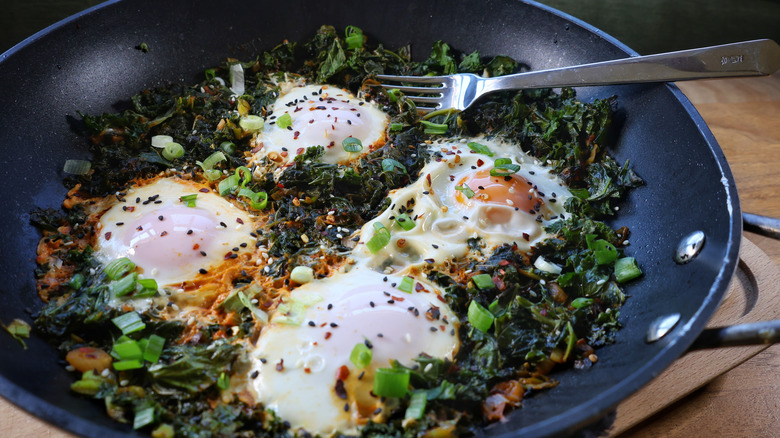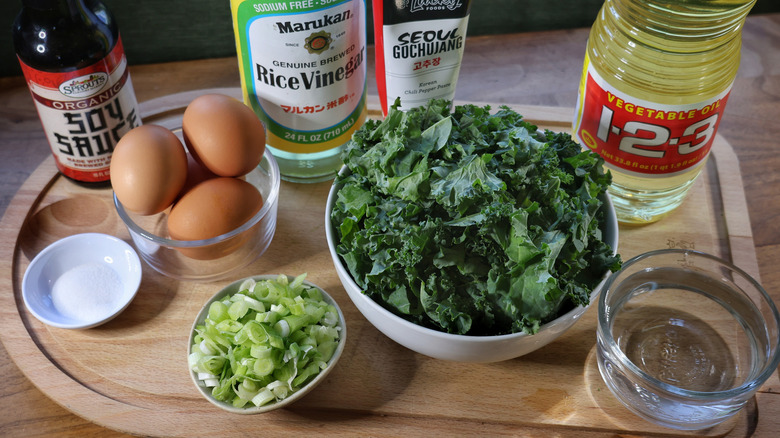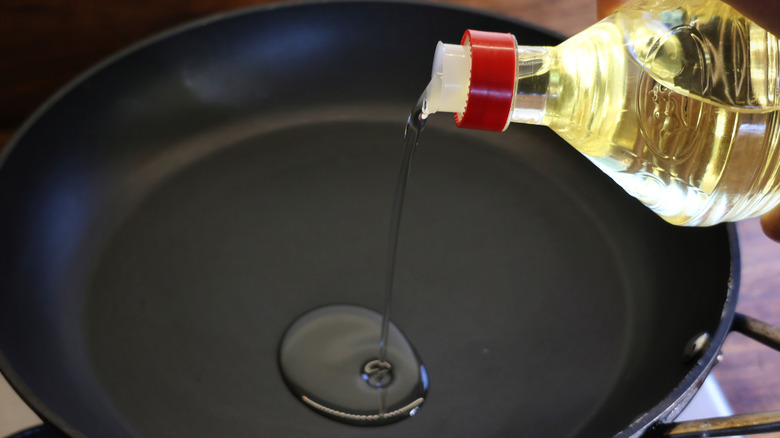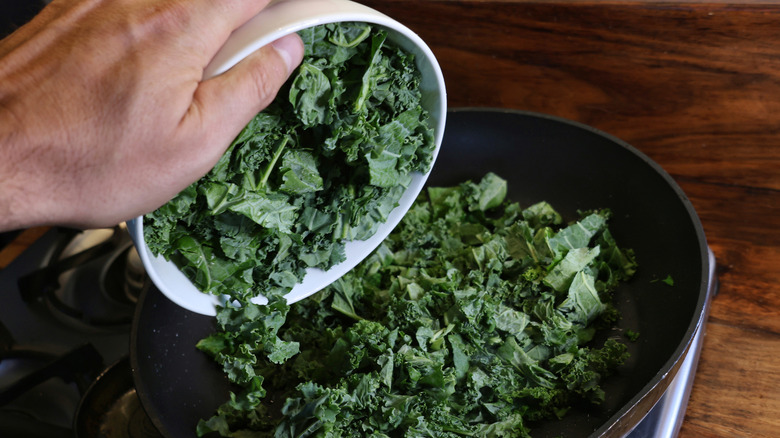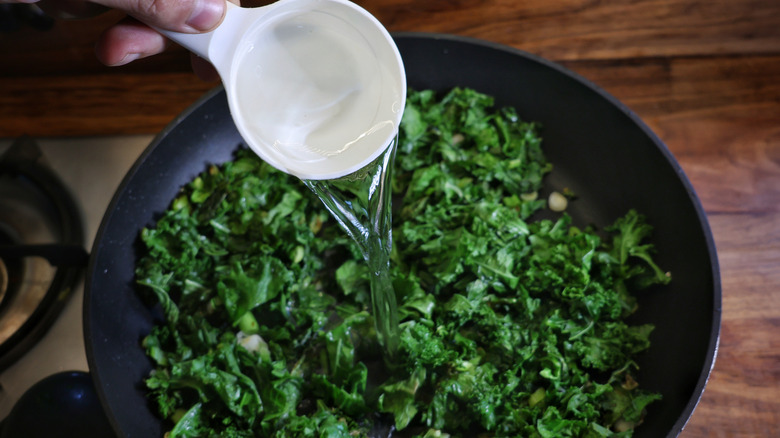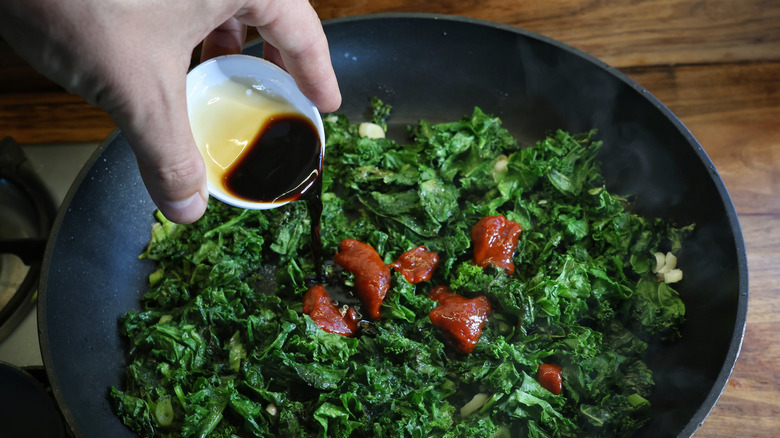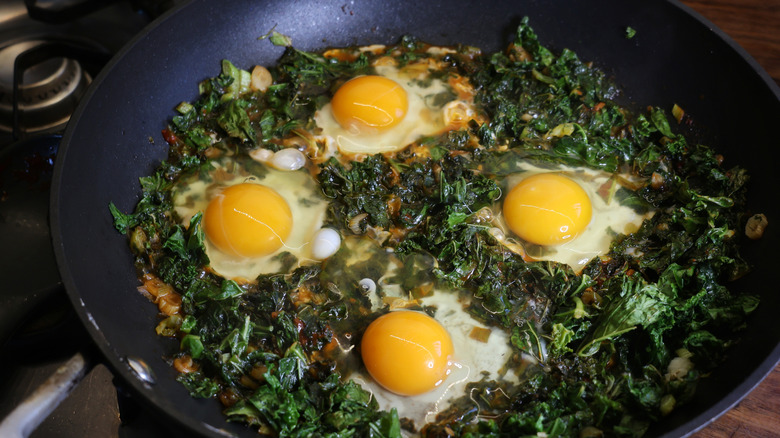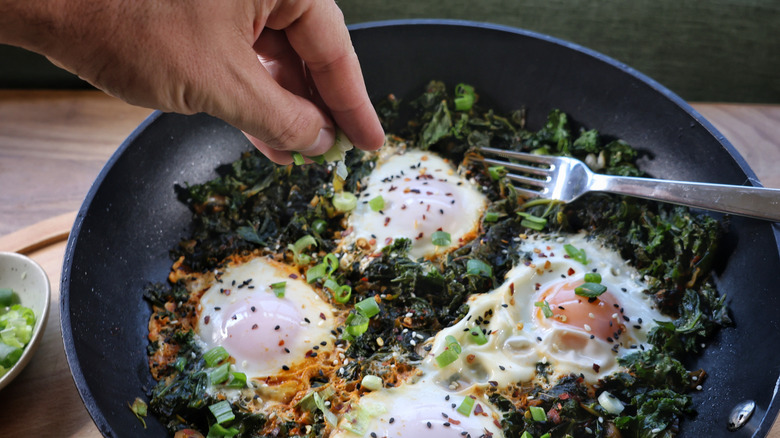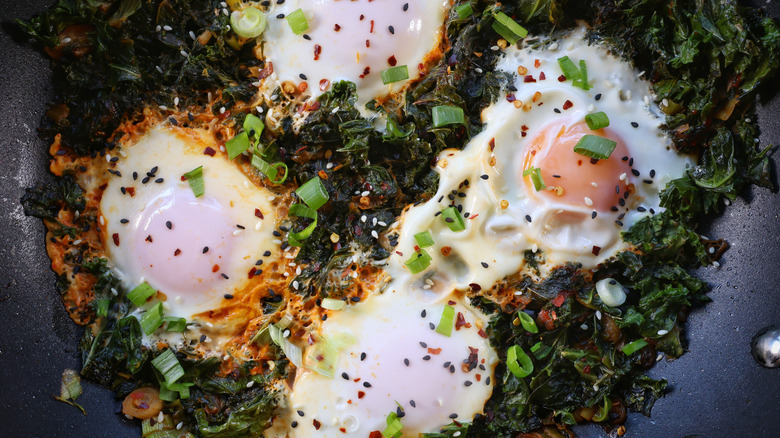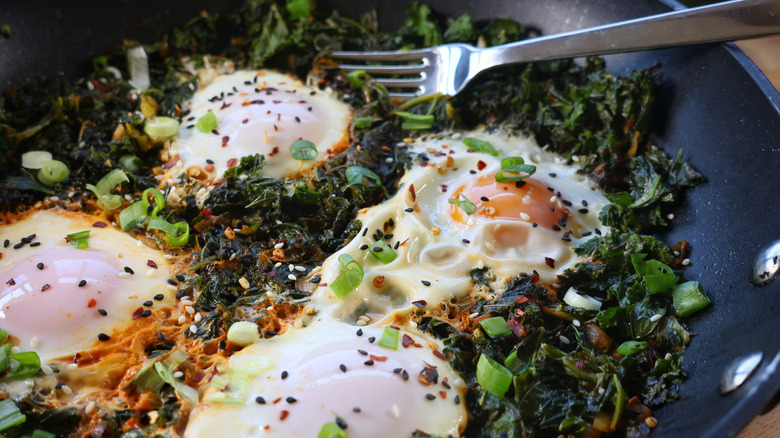Spicy Gochujang Kale And Eggs Recipe
As far as healthy breakfasts go, it's tough to beat a skillet of kale and eggs. It's loaded with nutrients and protein, a perfect way to start the day. The trouble is, kale and eggs can be a bit boring — not so with this recipe. These spicy gochujang kale and eggs provide all of that nutrition but also come with plenty of delicious, punchy flavor.
We lightly char the kale to bring out its deep, brassica flavors (think roasted broccoli), and then pair it with charred scallions (another delight) and a complex array of flavors in the form of salty soy sauce, spicy, umami gochujang, tangy rice vinegar, and just a touch of sugar to balance it all out. What you are left with is an amazing way to start your day: plenty of nutrients, a good dose of protein, and complex flavor. It's the perfect fuel for an adventurous day of hiking in the mountains, or just a healthy way to start a lazy Sunday.
Gather the kale and eggs ingredients
For this recipe, you will need vegetable oil (or other neutral oil), chopped kale, thinly sliced scallions, gochujang, soy sauce, rice vinegar, sugar, and eggs, as well as a bit of water. Once you have these ingredients together, you're only a few minutes away from a healthy, delicious breakfast.
Step 1: Heat the skillet
Bring a skillet to high heat and add the vegetable oil.
Step 2: Brown the kale and scallions
Add the kale and scallions to the pan and cook for around 5 minutes, until the kale and scallions begin to brown and char around the edges.
Step 3: Add water
Reduce the heat to medium, pour in ½ cup water, and stir. Cook this for 1 minute to allow the kale to soften.
Step 4: Season and steam
Next, stir in the gochujang, soy sauce, rice vinegar, sugar, and ¼ cup water. Cover and allow to cook for 2 minutes.
Step 5: Add the eggs
Make 4 wells in the kale and crack the eggs into these wells. Cover and cook for 2 minutes, or until the egg whites are cooked through. Remove from the heat.
Step 6: Garnish and serve
Garnish with thinly sliced scallions, toasted sesame seeds, and crushed red pepper, if desired. Serve immediately.
Spicy Gochujang Kale And Eggs Recipe
Start your morning off with a blast of flavor and nutrition with this easy, one-pot recipe for charred kale and eggs in a gochujang-based sauce.
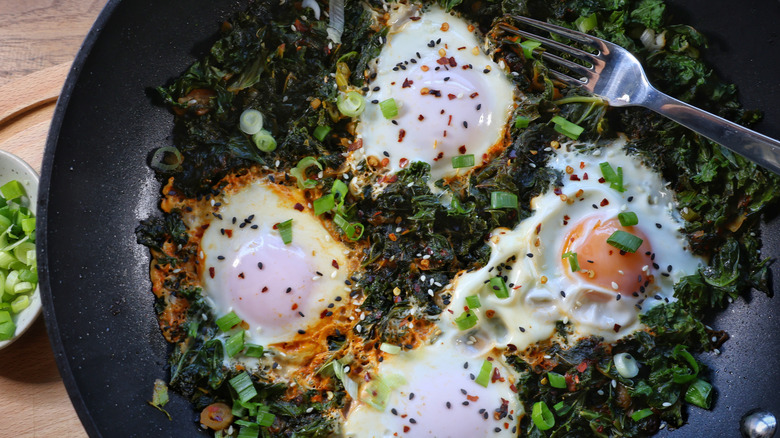
Ingredients
- 2 tablespoons vegetable oil
- 4 cups chopped kale
- ½ cup thinly sliced scallions
- 1 tablespoon gochujang paste
- 1 tablespoon soy sauce
- 2 teaspoons rice vinegar
- ½ teaspoon granulated sugar
- 4 eggs
Optional Ingredients
- Thinly sliced scallions, for garnish
- Toasted sesame seeds, for garnish
- Crushed red pepper, for garnish
Directions
- Bring a skillet to high heat and add the vegetable oil.
- Add the kale and scallions to the pan and cook for around 5 minutes, until the kale and scallions begin to brown and char around the edges.
- Reduce the heat to medium, pour in ½ cup water, and stir. Cook this for 1 minute to allow the kale to soften.
- Next, stir in the gochujang, soy sauce, rice vinegar, sugar, and ¼ cup water. Cover and allow to cook for 2 minutes.
- Make 4 wells in the kale and crack the eggs into these wells. Cover and cook for 2 minutes, or until the egg whites are cooked through. Remove from the heat.
- Garnish with thinly sliced scallions, toasted sesame seeds, and crushed red pepper, if desired. Serve immediately.
Nutrition
| Calories per Serving | 296 |
| Total Fat | 23.4 g |
| Saturated Fat | 3.8 g |
| Trans Fat | 0.1 g |
| Cholesterol | 319.9 mg |
| Total Carbohydrates | 7.9 g |
| Dietary Fiber | 2.9 g |
| Total Sugars | 2.9 g |
| Sodium | 908.2 mg |
| Protein | 14.3 g |
What can I use as a substitute for gochujang?
We've all been there — shopping at the grocery store for a recipe you're excited to cook, and one of the key ingredients is nowhere to be found. Do you scrap the recipe entirely or persevere and try to find a replacement? It's never an easy decision to make, but you can often find a good replacement.
When it comes to gochujang, this can be especially vexing. Gochujang is a Korean chile paste made with fermented soybeans, gochugaru (Korean chili powder), glutinous rice, salt, and sometimes sweetener. It's packed with flavor and difficult to replicate exactly. But, there are options for gochujang substitutes.
Perhaps the most popular replacement for gochujang is sriracha. Sriracha is a Thai chile sauce made with ripe, red jalapeños, garlic, and sugar, among other ingredients. The flavor is quite different from gochujang but can fill some of the same roles, adding heat, sweetness, and a touch of umami. Though, notably, the umami flavor in sriracha largely comes from garlic, whereas gochujang derives its umami from fermented soybeans.
Another option for replacing gochujang is a mixture of tomato paste and chile powder. Tomato paste has a similar flavor profile to gochujang, providing a deep umami with a touch of sweetness, though obviously without the heat. A touch of crushed red pepper or chile powder can fill that gap and create a workable alternative.
Which variety of kale is best to use for sauteeing?
While it may seem like kale is kale, there are actually a surprising number of kale varieties out there. Even an average grocery store these days often has three or more on the shelves, each with their own specific characteristics that make them better — or worse – suited to a specific dish. So, how do you choose the best kale variety for the recipe you're making?
To make this sort of decision properly, it's important to first understand a bit about kale. Kale is a member of the brassica family, which also includes other stalwarts such as broccoli, cauliflower, cabbage, and Brussels sprouts. Brassicas are hardy, cold-tolerant vegetables that have a long history as winter crops. Within the kale branch of the brassica tree, there are many varieties, though you'll likely only see a handful at your local grocery store.
The most common kale varieties at the market are curly kale (probably what you imagine when you think of kale), red or purple kale (similar in appearance but with reddish purple stems), dinosaur or lacinato kale (thicker, darker, smooth-edged leaves), and baby kale. Among these, your best choice is to go with either curly kale or purple kale for sauteing. These varieties have plenty of tooth but still cook down quickly to a nice cooked greens consistency. Baby kale is too tender and behaves more like spinach, while lacinato kale is a bit tougher and is better suited to stews and braises.
